This post may contain affiliate links. Please read our disclosure policy.
Vegan hot pot is one of my favorite meals to share with family and friends. With a creamy soy milk broth, fresh veggies, tofu, and noodles, it’s cozy, comforting, and packed with flavor—perfect for plant-based eaters or anyone looking for something delicious and fun.
If you’ve never made hot pot before, don’t worry! I’ll guide you through it step by step. It’s easier than you think and such a great way to enjoy time together around the table. Serve it with my Top 5 Hotpot sauces for a delicious and healthy cozy meal in no time!
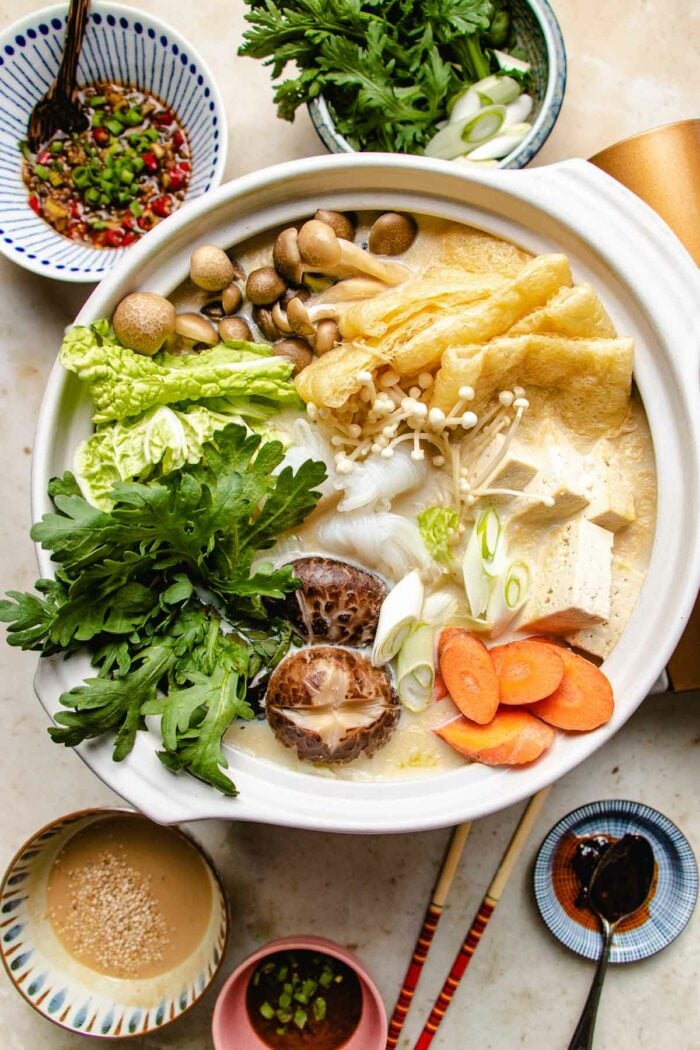
Table of Contents
What is hot pot made of?
Hot pot is a fun and interactive meal where fresh ingredients are cooked at the table in a simmering pot of broth. For a vegan hot pot, the focus is on plant-based broths like creamy soy milk or kombu, paired with fresh veggies, mushrooms, tofu, and noodles. It’s perfect for beginners because it’s easy to prepare and totally customizable!
There are five key parts: the broth, vegetables, dipping sauces, add-ons, and protein alternatives like tofu or plant-based options. The broth is the only part that’s cooked ahead of time. Everything else, like thinly sliced veggies and other ingredients, is cooked right at the table in the bubbling hot broth.
Vegetable hotpot components
One of the best things about making a vegetarian hot pot is the endless variety—you get to pick and choose what goes into the pot! Whether you’re a fan of leafy greens, hearty root vegetables, or chewy noodles, it’s all about mixing your favorites to create a meal that’s fun, cozy, and satisfying.
Soup base
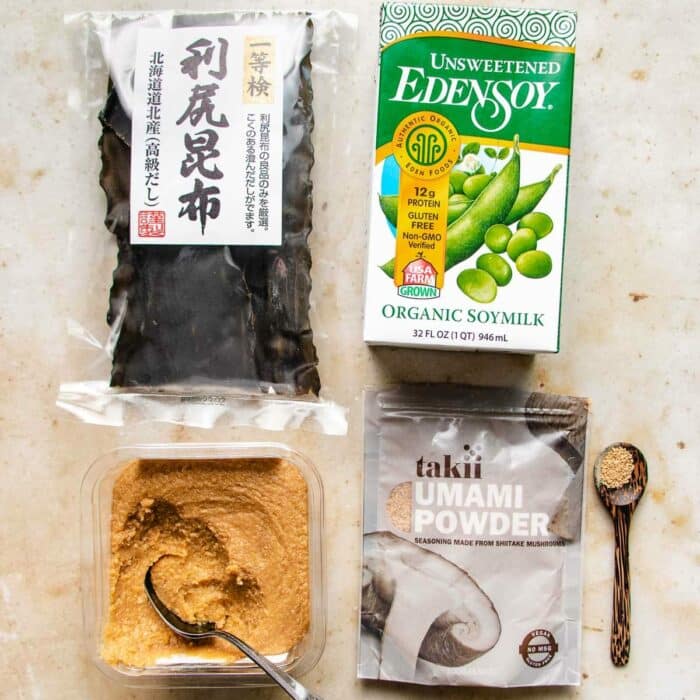
Save This Recipe
- Start with a creamy and flavorful base using soy milk, dried kelp (kombu), shiitake mushroom seasoning (product), and white miso (or chickpea miso).
- Tip: See our hot pot broth for more varieties!
Dipping Sauces
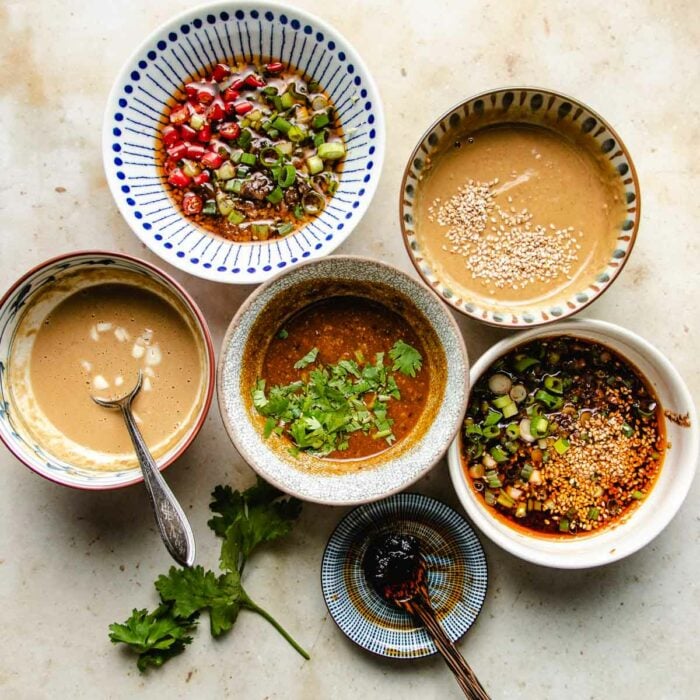
Choose from five hot pot dipping sauces: Taiwanese shacha, garlic sesame, Chinese spicy chili garlic, Japanese miso, or spicy peanut sauce.
Hot pot vegetables and tofu (pick and choose)
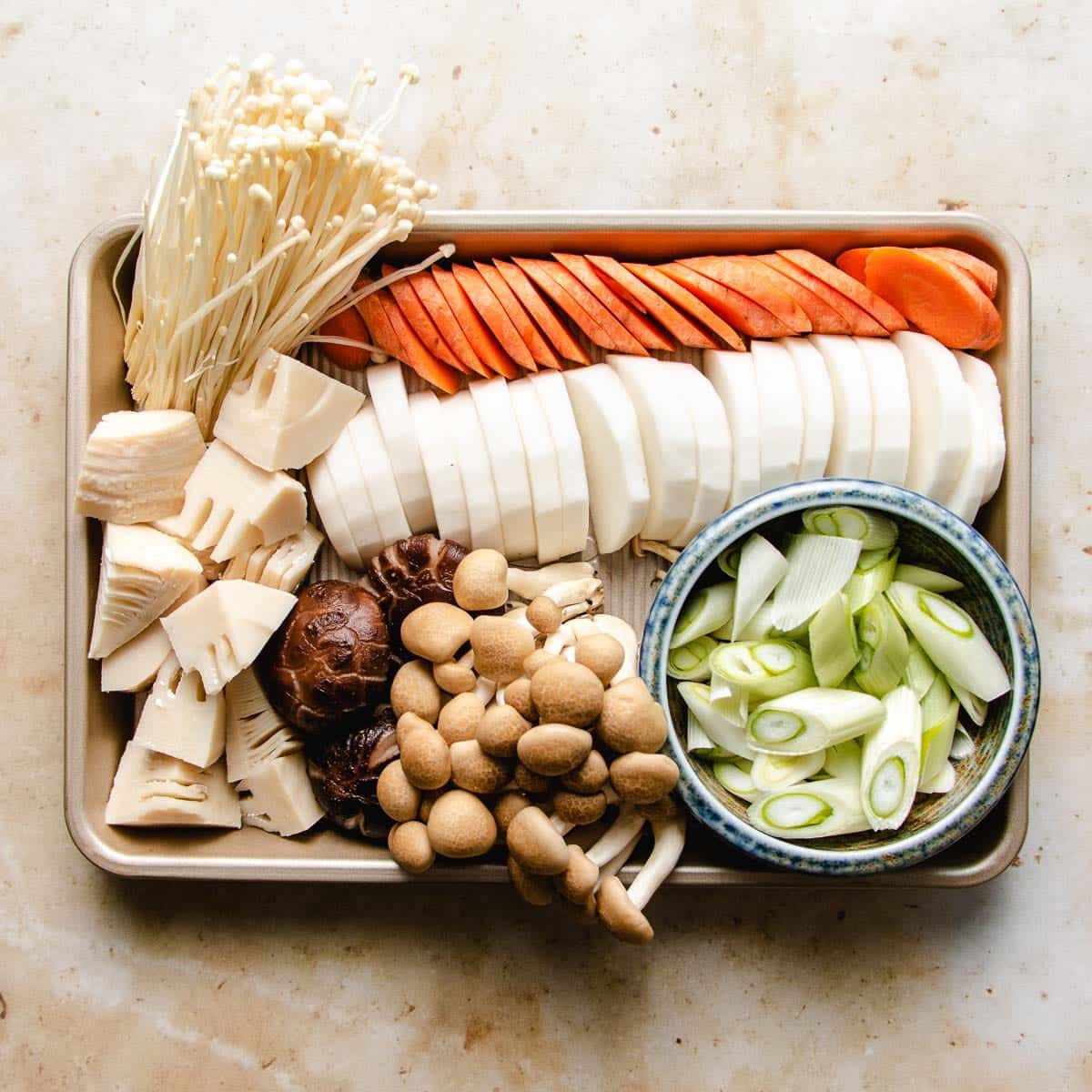

- Veggies: Tong hao, Napa cabbage, carrots, daikon radish, different types of mushrooms, Japanese leek (or spring onion), and bamboo shoots.
- Tofu proteins: Fried tofu puffs and organic firm tofu.
- Carbs: Shirataki noodles, ramen, or rice cakes for a chewy, hearty texture.
Tools and equipment
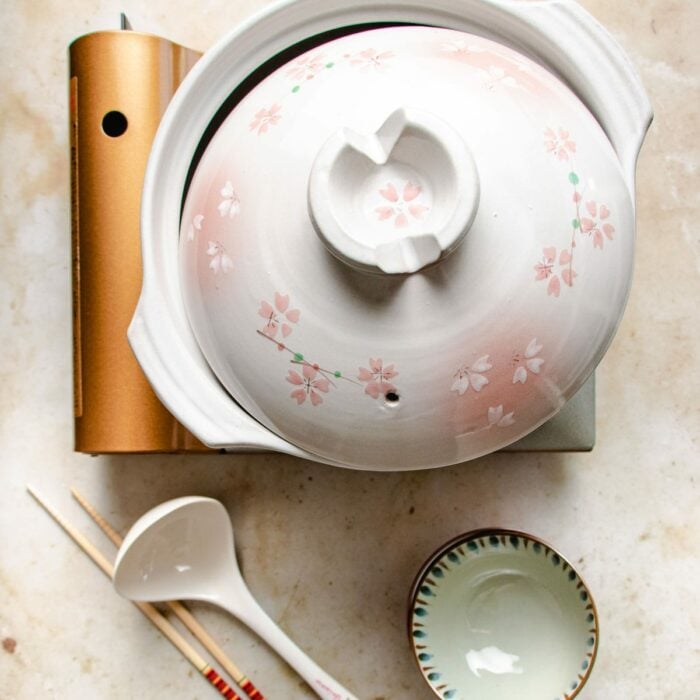
- You’ll need a 4-5 qt. soup pot like a Donabe, stainless steel hot pot, or Dutch oven. Grab chopsticks, a soup ladle, a strainer scoop, serving bowls, and, if you want the full experience, a portable burner to cook right at the table.
Tip
What is kombu
Kombu, also known as dried kelp, is a key ingredient for adding rich flavor to soup broths. It’s especially important in vegetarian hot pot soup bases. Using it is simple—just add a small piece to water (or broth) and simmer for 15-20 minutes. As it rehydrates, the kombu softens and becomes edible.
How to make vegetable hot pot
Hot pot is all about cooking and enjoying together! The broth is the only part prepared ahead, while the rest—vegetables, tofu, and noodles—are cooked right at the table as everyone eats and chats.
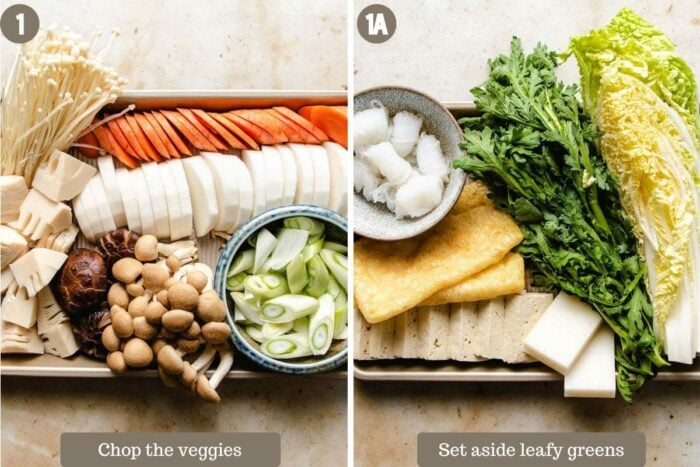
- Prep the Vegetables: Dice, wash, and prepare all the veggies.
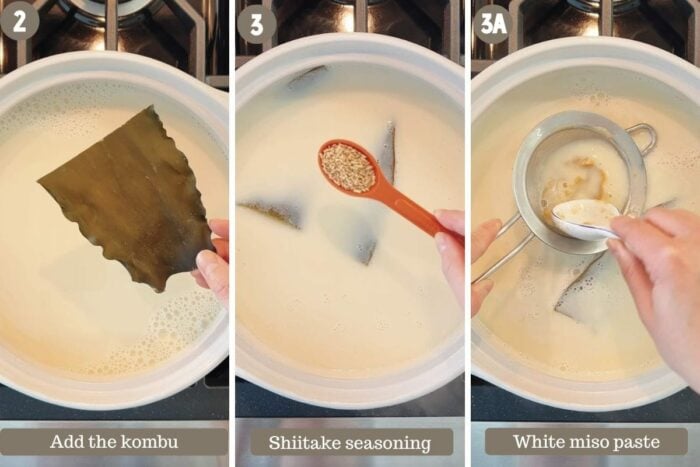
- Make the Soup Base: Simmer soy milk, water, and kombu gently for 12-15 minutes. Leave the kombu in for added flavor and texture.
- Tip: To prevent curdling, keep the heat low while simmering this milk-based broth.
- Season the Broth: Stir in mushroom powder and dissolve the miso paste into the broth.

- Add Hearty Ingredients First: Start with daikon, carrots, shiitake mushrooms, Japanese leek, and bamboo shoots. Simmer on low heat for 10 minutes.
- Add Tofu and Mushrooms: Add fried tofu, firm tofu, enoki, and shimeji mushrooms, along with the napa cabbage stems. Continue to simmer for another 10 minutes.
- Add Soft Leafy Greens: Add napa cabbage leaves, tong hao, shirataki noodles, and rice cakes (if using).
- How to Serve and Enjoy: Cook each layer as you eat, dipping them into your favorite hot pot sauces. Sip the rich broth—it’s comforting and perfect for chilly days!
Good to know
Hot pot broth tips
- Simmer, Don’t Boil: Use low heat to gently simmer the soy milk broth. A slight curdle is normal and won’t affect the flavor.
- Keep the Broth Level Right: Fill the pot about 70-75% full to avoid spills and make sure even cooking. Add more hot water mixed with soy milk as needed during the meal.
What vegetables and tofu can I put into the broth?
When it comes to hot pot, the options are endless! Let’s break it down by what vegetables and tofu work best for creating a flavorful and satisfying meal.
- Leafy Green Choices: Tender greens like tong ho, baby bok choy, yu choy sum, Napa cabbage, snow pea leaves, and Chinese spinach are perfect for hot pot. These cook quickly and should be added just a few minutes before serving.
- Root Vegetable Choices: Hearty veggies like lotus root, carrots, and daikon are great for adding texture and sweetness. These take longer to cook, so add them toward the beginning of your hot pot session.
- Hot Pot Tofu Ideas: For tofu, try bean curd skin, frozen tofu, fried tofu puffs, egg tofu, or silken/soft tofu. Each adds a unique texture and absorbs the broth beautifully.
- Mushrooms: Shiitake, enoki mushrooms, oyster mushrooms, or king oyster are all great choices.
📌 See my guide on Chinese vegetables for more information and ideas!
What to do with leftovers
Leftovers & Reheating: Store any leftovers in a large airtight container—no need to separate the broth and cooked ingredients. Reheat everything on the stovetop for an easy and delicious day-two hot pot meal. For the best flavor, finish the leftovers within 3 to 4 days.
Make-Ahead Tip: This vegetable hot pot is perfect for prepping ahead! Dice, wash, and prepare all the ingredients in advance, and you can even prepare the broth a day ahead. The flavor will deepen overnight, so thin it with more water and soy milk before serving.
Chihyu’s helpful notes
- Simmer, Don’t Boil: Use low and gentle heat for the soy milk broth to prevent curdling. A slight curdle toward the end is normal and doesn’t affect the flavor.
- Add Ingredients in the Right Order: Start with hearty veggies like carrots, daikon, and lotus root, which take longer to cook. Tender greens and quick-cooking ingredients like napa cabbage leaves and tofu should be added last.
- Keep the Broth Level Balanced: Fill the pot about 70-75% full to avoid spills. Top up with more hot water or soy milk as needed during the meal.
- Prepping Makes It Easy: Dice and wash all the vegetables in advance, and you can even make the broth a day ahead for deeper flavor.
- Use the Right Pot: A large soup pot or Dutch oven (at least 4-quart) works perfectly to avoid spills.
- No portable stove? No problem—just simmer everything on your stovetop and serve the hot pot family-style.
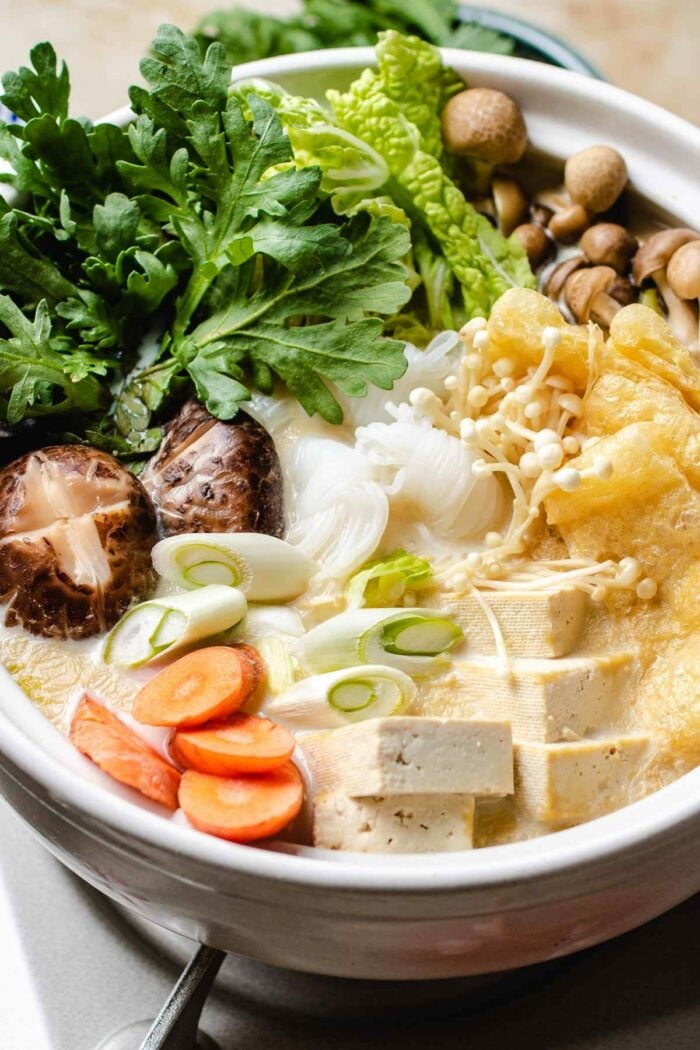
Vegan hot pot recipe

Ingredients
For the soup base:
- 2 cups soy milk unsweetened
- 3 cups water
- 3×3 inch dried kombu
- 2 tsp Shiitake mushroom seasoning I use Takii's
- 2-3 tbsp White miso (reduced salt) or chickpea miso
For the hot pot (pick-and-choose): There are no “must-have” items, so mix and match your favorites!
Hearty vegetables:
- 1 large Carrots sliced on diagonal
- 1 small Daikon radish outer skin peeled and diced
- 1 bulb Japanese leek Negi, or spring onion, sliced
- 16 oz Boiled bamboo shoots diced to bite sizes
Mushrooms:
- 4-6 whole pieces Shiitake mushroom stems removed sliced, or leave in whole with
- 200 g Enoki mushrooms roots trimmed away
- 100 g Shimeji mushrooms roots trimmed away
Tofu:
- 100 g Fried tofu
- 14 oz Organic firm tofu
Tender leafy greens:
- 1/4-1/2 one small Napa cabbage diced and separate stems from the leaves
- 1 bundle Tong hao aka Shingiku
Other add-ins:
- 1 packet Shirataki noodles or kelp noodles
- 4-6 pieces Rice cake
For hotpot dipping sauces:
- hotpot sauces or store-bought
Tools/Equipment:
- 4 qt. Donabe Japanese clay pot, or a 4-quart size large pot for 4-5 people.
- Chopsticks
- Soup ladle
- Individual serving bowls
- Portable stovetop optional
Instructions
- Hot Pot Vegetable Prep: Dice, wash, and prepare all the vegetables.
- Make the Soup Base: Combine soy milk, water, and kombu in a pot. Cover with a lid and simmer on low heat until gently simmering, about 12-15 minutes.
- Season the Broth: Stir in the mushroom powder and dissolve the miso paste into the broth.
Add Ingredients in Layers:
- Start with daikon, carrots, shiitake mushrooms, Japanese leek, and bamboo shoots—these take the longest to cook. Simmer on low heat for 10 minutes.
- Add the fried tofu, firm tofu, enoki, and shimeji mushrooms, along with the napa cabbage stems. Continue to simmer for another 10 minutes.
- Finally, add the napa cabbage leaves, tong hao, shirataki noodles, and rice cakes (if using).
- Serve and Enjoy: Cook each layer as you eat, dipping them into your favorite hotpot sauces. Don’t forget to sip the broth—it’s rich, comforting, and perfect for chilly winter days!
Notes
- Low Heat is Key: Simmer the milk broth on low heat and check periodically to prevent spilling. Avoid a rolling boil to maintain the silky texture.
- Curdling is Normal: A slight curdle may occur toward the end—this won’t affect the flavor.
- Pot Size Matters: Use at least a 4-quart pot or Dutch oven to accommodate all the ingredients without spilling.
- Ingredient Order: Add heartier vegetables like daikon and carrots first. Aromatics, such as leeks and shiitake, need more time to release their flavor.
- Leftovers: Store extra hot pot ingredients in the fridge for a day-two hot pot session. For the best taste, finish them within 3 to 4 days.
- Fried Tofu Puff Storage: Keep uncooked fried tofu puffs in the freezer for freshness.
- Make-Ahead Tip: This vegetable hot pot is perfect for prepping ahead! Dice, wash, and prepare all the ingredients in advance, and you can even prepare the broth a day ahead. The flavor will deepen overnight, so thin it with more water and soy milk before serving.
Nutrition
Nutrition information is automatically calculated, so should only be used as an approximation.
Made a dish and loved it? Please rate the recipe and leave a comment in the section below! It helps my blog grow organically, allowing me to continue sharing free and awesome content with you. Thank you!
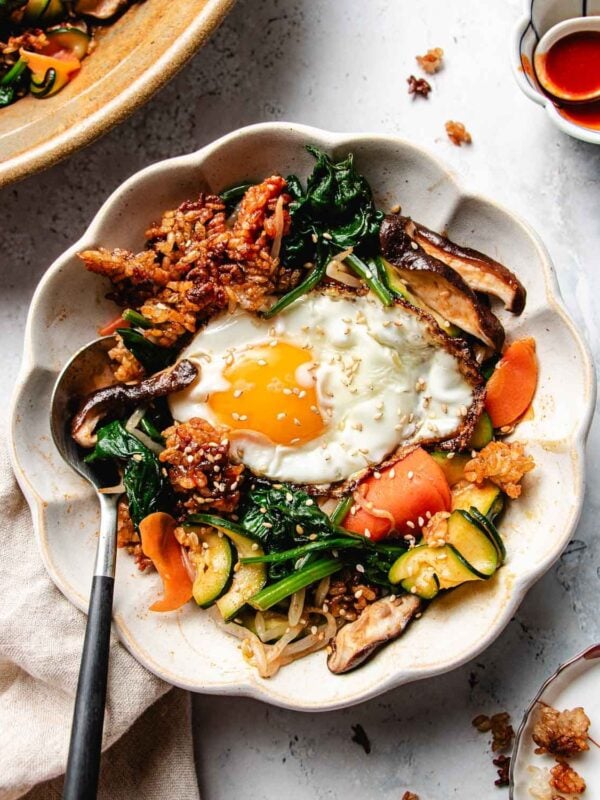
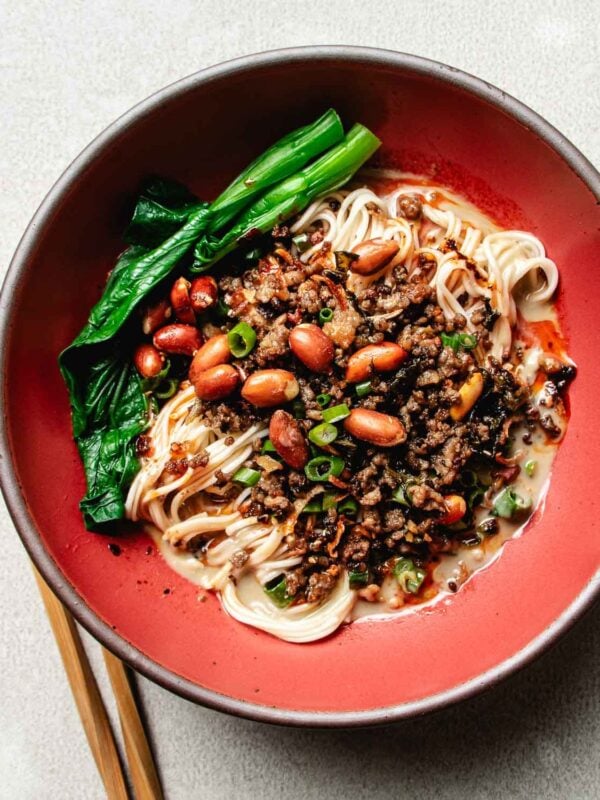

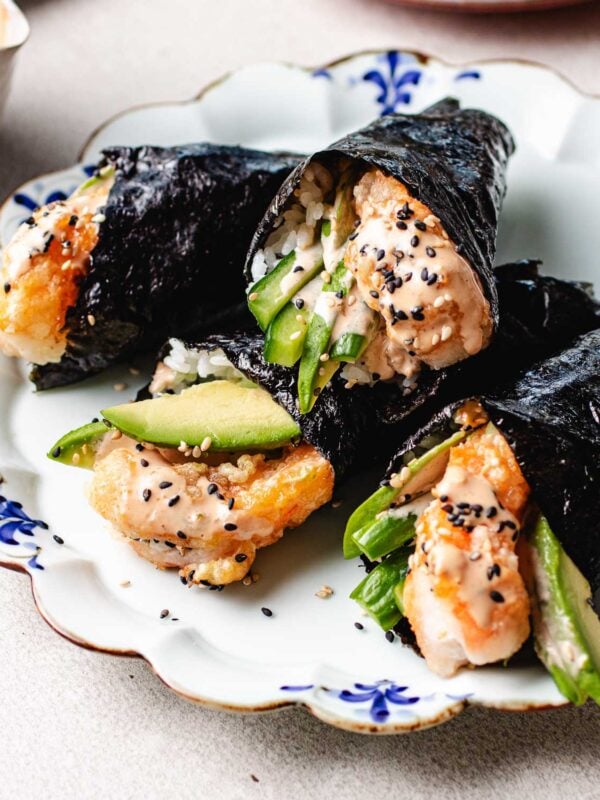









I would love to try this recipe. I have family members who want to have beef in it. What beef cut would you recommend? I don’t want to buy the pre-cut thinly sliced from the Chinese supermarket as they are not grass-fed.
Hi Lily,
For shabu-shabu/hot pot, tender cuts like sirloin, ribeye (leaner section), top round, eye of round, or tenderloin work great. They’re flavorful, tender, and not overly fatty. You can ask your butcher to slice them super thin or freeze the beef for an hour before slicing at home.
For this broth, made with creamy miso and soy milk, I prefer pan-searing red meat on the side. A quick marinade with soy sauce, sesame oil, mirin or sake, salt, and pepper works wonderfully. This way, it doesn’t interfere with the flavor of the broth.
I also have more hot pot broth recipes you can try. They can be found here – https://iheartumami.com/hot-pot-broth/
Hi Chih Yu,
Thank you for your recommendations. I had top sirloin in my freezer so that’s what I used. To be sure the meat will be tender, I marinated with coco amino and baking soda. It turned out great with chicken stock base. Your ShaCha sauce was so delicious. The dried shrimp powder you recommended on Amazon was not available and I couldn’t find it anywhere else so I used dried shrimp and chopped them up. I will never buy the store-bought sauce again.
I haven’t had hot pot for at least 2 years because I was avoiding seed oil. Your recipe was a hit and everyone in my family thoroughly enjoyed the hot pot. Thank you!!
Lily
Hi Chih Yu,
Thank you for your recommendations. I had top sirloin in my freezer so that’s what I used. It turned out great. I marinated it with coconut amino and baking soda just to ensure tenderness. Everyone in my family thoroughly enjoyed it.
Your Sha Cha sauce was so delicious. I couldn’t find the dried shrimp powder you recommended on Amazon or any other ones, so I just used dried shrimp and chopped them. I haven’t had hot pot in over 2 years because I didn’t want to use the store-bought Sha Cha sauce. Your sauce was perfect. Thank you so much. I can make hot pot again.
By the way, I’m looking to make black bean sauce noodles gluten-free of course. Do you have a recipe for the black bean paste to make the sauce?
Thank you so much, Lily. I’m so happy to hear that. No black bean sauce yet but I love that dish! I’ll add it to my to-make list! Thank you again!
My whole entire family enjoyed this hotpot so much! It was our thanksgiving family gathering dish and we served with some beef and chicken on the side. It was perfect as some of our guests were plant-based and others were not. The broth is out of this world flavorful. So luxurious! Can’t believe it’s simple to make, too! This will be our go to winter dish now
Thanks so much. So happy to hear!
Hotpot at home = Sign me up! One of my favorite pre-pandemic activities was going to hotpot, but since I’ve been staying in more I needed a way to bring this deliciousness home. This recipe was a HOME RUN for my family and I cannot wait to make it again. It was SO delicious and SO easy to make. Absolutely filling and soothing. Definitely a repeat recipe that I’m excited to make over and over!!!
Thank you so much, Sam! I’m so so happy to hear that. Appreciate you as always! XOXo!
We made this vegan hot pot the other day because the weather is so cold here and even my non-vegan husband loved it! He kept saying the soup broth tastes Luxurious! It reminds me of the shabu shabu we had in Kyoto – smooth, creamy, yet full of umami flavor. SO GOOD! I added all the vegetables I had and quickly blench some beef in a separate pot for my husband and combine it with his bowl.
Highly recommend it! Perfect for winter!
Thank you so much!